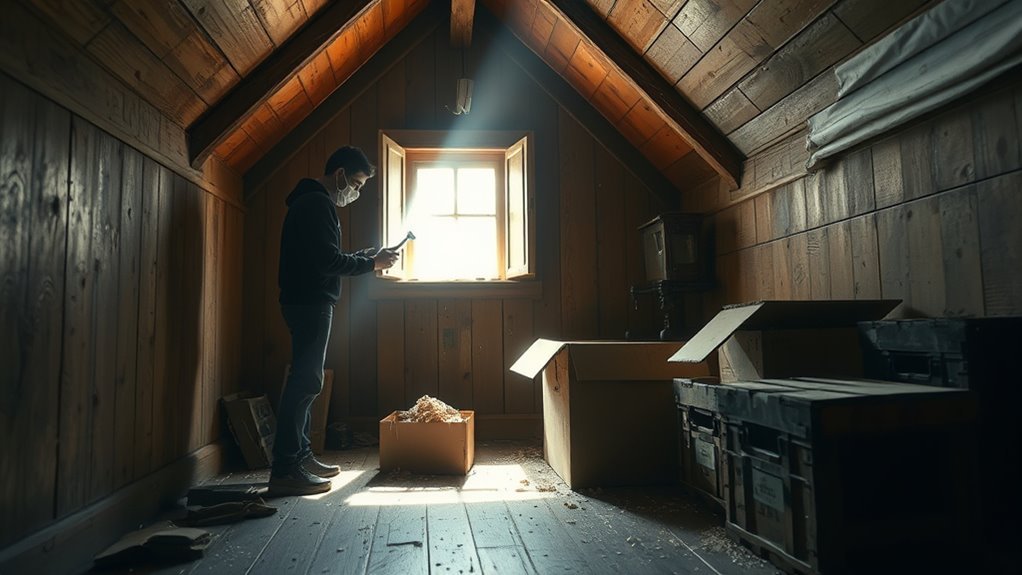How to Clean Your Attic in 10 Minutes
To clean your attic in 10 minutes, start by grabbing basic supplies like gloves, a broom, and a garbage bag. Quickly remove large trash or debris first to free up space. Then, dust high surfaces and sweep loose dirt briskly. Group any leftover items into categories using clear bins for easy access. Finally, ventilate the space to refresh the air and check for signs of pests or damage. If you want to make the most of your attic, there’s more helpful guidance ahead.
Gather Your Cleaning Supplies

Before you begin cleaning your attic, you’ll need to gather a few essential supplies. Having the right cleaning tools on hand will make the job quicker and less stressful. Grab a sturdy broom, dustpan, microfiber cloths, and a vacuum with a hose attachment to reach tight corners. Don’t forget a reliable garbage bag for smaller debris. Safety gear is just as important—put on gloves to protect your hands, a dust mask to avoid inhaling allergens, and safety goggles to shield your eyes. If your attic has low lighting, a headlamp or portable light will give you freedom to move without fumbling in the dark. By prepping these essentials, you’re setting yourself up for a smooth, efficient attic cleaning session.
Clear Out Large Debris and Trash
Once you’ve gathered your supplies, start by removing large debris and trash from the attic. This step is key to applying effective decluttering strategies, freeing up space, and making trash disposal easier. Work systematically, focusing on one section at a time to avoid overwhelm.
| Item Type | Action Needed | Disposal Method |
|---|---|---|
| Old boxes | Break down | Recycle or trash |
| Broken furniture | Disassemble | Bulk trash pickup |
| Random debris | Bag separately | Local waste center |
Dust and Sweep Surfaces Quickly

Grab a duster and a broom to quickly remove dust and dirt from all surfaces in your attic. Don’t get bogged down—focus on swift dust removal to free the space from years of buildup. Start with the highest spots like rafters and beams, then sweep down to shelves and the floor. Use a microfiber duster for better dust capture without scattering particles. When sweeping, keep movements deliberate but quick to gather loose debris efficiently. This surface cleaning approach clears your attic fast, making the environment healthier and more inviting. Remember, the goal is to reclaim your attic space with minimal effort and maximum impact, so keep tools handy and stay focused. With just these simple steps, you’ll have a cleaner, fresher attic in no time.
Organize Remaining Items Efficiently
A clutter-free attic starts with organizing the items you’ve decided to keep. To create a sense of freedom and ease, focus on smart item categorization and practical storage solutions. Here’s how to get started:
- Group similar items together—seasonal decorations, tools, or keepsakes—so you can find what you need without hassle.
- Use clear, labeled bins or stackable containers to maximize space and keep everything visible.
- Designate zones for each category to maintain order and avoid future chaos.
Ventilate and Inspect the Attic Space

Before sealing up your attic, you should ventilate and inspect the space thoroughly. Good ventilation keeps your attic fresh, prevents moisture buildup, and protects your attic insulation from damage. Open vents or windows to let fresh air flow freely, giving your attic a chance to breathe.
While you’re at it, check for signs of pests or damage. Look for droppings, nests, or chewed materials—early pest control can save you headaches later. Also, inspect the attic insulation for damp spots or gaps that reduce its effectiveness. Fixing these issues now means better energy efficiency and a healthier home environment.
Taking these simple steps grants you freedom from future problems, ensuring your attic stays clean, safe, and well-maintained with minimal effort.
Frequently Asked Questions
How Often Should I Schedule a Deep Attic Cleaning?
Think of your attic like a garden that needs seasonal maintenance to stay healthy and organized. You should schedule a deep attic cleaning at least twice a year—once in spring and once in fall—to keep clutter in check and guarantee proper attic organization. This routine helps you avoid a mountain of problems later, giving you the freedom to enjoy your space without stress or surprise repairs down the road.
What Safety Gear Is Recommended for Attic Cleaning?
You’ll want to gear up properly before diving into attic cleaning. Always wear gloves to protect your hands from sharp objects and insulation irritants. A dust mask is essential, too—it keeps you from breathing in dust, mold spores, or any pesky allergens trapped up there. If you want to move freely and safely, consider goggles and long sleeves as well. Staying protected means you can clean with confidence and enjoy your attic’s freedom afterward.
Can I Use a Vacuum Cleaner in the Attic?
You might wonder if using a vacuum cleaner in your attic is a wise move. The truth is, it can be, but you’ll want to pick the right vacuum cleaner types—like a shop vac or one with a HEPA filter—to handle dust and debris effectively. For attic vacuuming tips, use attachments to reach tight spots and avoid stirring up too much dust. This way, you keep your attic clean without sacrificing your freedom to breathe easy.
How Do I Handle Pest Infestations Found in the Attic?
When you discover pests in your attic, start with thorough attic inspections to identify the problem areas. You’ll want to take charge by sealing entry points and removing any nests or droppings. For effective pest control, consider natural repellents or call a professional if it’s overwhelming. Staying proactive lets you reclaim your space, giving you the freedom to enjoy a clean, pest-free attic without hassle.
What Are Signs of Mold or Water Damage in an Attic?
You might think spotting mold or water damage in your attic is tough, but it’s simpler than you expect. Look for musty odors, dark spots, or fuzzy patches—that’s mold identification at its core. Water damage shows as warped wood, stains, or damp insulation. Catching these signs early helps you keep your freedom from costly repairs and health issues. Stay vigilant, and your attic stays a safe, dry space.






